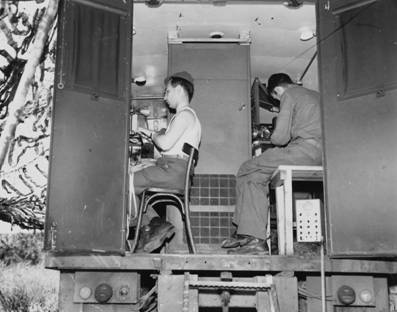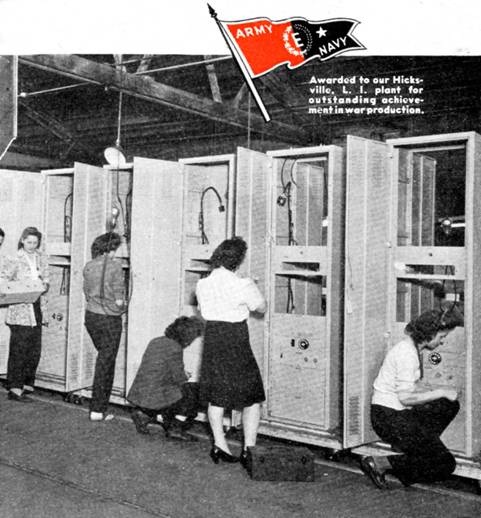Press Wireless
Vicky Penner Whitaker, HHS 1958, emailed me in response to last month's article, and shared with me some childhood memories of life in wartime Hicksville. She mentioned being with her mother and grandmother as they used their Ration Stamps at the old A&P on the east side of Broadway at Herzog Place, near the bank buildings. She also recalled the special blackout shades that her mother would secure. Her family's shades were considered unusually important because the Penners lived next door to Press Wireless.
What was Press Wireless? This anecdote may give you some idea of its role:
Five days after D-Day, a special radio installation on Long Island received the first direct wartime radio transmission from the Normandy beaches. Over the next seven days, 200,000 printed words from various war correspondents followed, and American media were able to report about post-invasion developments almost as soon as they happened. This direct reporting from Normandy was Press Wireless's idea, and it was accomplished by PW people, using a PW transmitter and other PW equipment made in Hicksville.

Two technicians of the broadcasting crew working in the
transmitter truck at Normandy, July 1944; note the camouflage
netting draped over the truck's left side
www.tmchistory.org/PressWireless/Prewi_company_history.htm
Getting news so soon seemed miraculous to the public, and if the public had known the details, it would have seemed even more so. Thanks to a U-boat, one of the mobile 400W transmitters made by PW had not made it to Europe. The one that was sending news back home had made it to England, then had crossed the rough Channel in an LST, and bounced ashore through the surf and sand in an Army truck - and it still worked. Now the truck was parked near some trees in a pasture, draped in camouflage netting, sending news that was relayed across America. Despite months of planning, PW had not yet been granted a dedicated radio frequency for the new station, so the lead station operator improvised. He chose a frequency already assigned to PW and certain news media for other purposes. Across the Atlantic, someone picked up the transmission, realized what was going on, and everyone involved agreed to keep that frequency clear for the Normandy station.
There's room here for only a brief overview of PW and everything it did.
As radio became established in the 1920s, "paper news" publishers began working together to establish a radio-based infrastructure by which news could be disseminated quickly and fairly. By 1931, the effort had morphed into Press Wireless Corporation, a public utility. A large transmitting site was established in Hicksville, and a site for receiving was created in Little Neck. In less than a decade, the bulk of transmitting had moved to a 500-acre site in Centereach. The Hicksville site (now probably smaller than before) then served multiple purposes, including the manufacture of special-purpose equipment for internal use and for corporate and military clients.
Eventually, PW had operational offices in 62 countries; most of them used teleprinters. Generally, these devices turned text radio signals into printed language in a variety of languages, using the appropriate alphabet (or, in the case of Chinese or Japanese, the appropriate characters). Special teleprinters turned radio fax signals into printed images. PW's global network earned praise from its clients for dependability.
During the War, both the news and military work (the latter coordinated through the U.S. Signal Corps) that PW did were of high priority. In addition to enabling media to report on what was happening, Hicksville produced the long-distance transmitters and Dual Diversity Receivers* that the military needed to coordinate operations over large areas. Secondarily, Hicksville also became the broadcast point for relaying Voice of America programming to Europe via short wave.
*In simple terms, a Dual Diversity Receiver uses a combination of circuitry and multiple antennas to maximize the clarity of signals that would otherwise be distorted by having bounced off distant buildings, cliff faces, etc. This is exceptionally important when transmissions are sent from low ad hoc locations near, say, battlefields.

Employees of Press Wireless in Hicksville, constructing
advanced Dual Diversity Receivers for use by the U.S. Army
The pennant signified that a given factory had received an Army-Navy E Award,
in honor of "Excellence in Production." Far fewer than 5% of all defense plants
were honored in this way. The star visible on this pennant signified that the plant
had been honored again, for sustaining excellence after first receiving the award.
advertisement in Electronics, May 1944
There is much more that could be said about Press Wireless. If you're interested in reading further, please go to https://www.tmchistory.org/PressWireless/Prewi_company_history.htm
***

